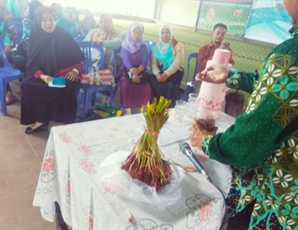Pembuatan Teh Bawang Dayak dan Manfaatnya Bagi Kader Pusat Kesehatan Masyarakat Harapan Baru Samarinda Seberang Production of Bawang Dayak Tea and Its Benefits for Cadres of Harapan Baru Community Health Center Samarinda Seberang
Main Article Content
Abstract
The community service activity was attended by cadres of Harapan Baru Community Health Center (Puskesmas) Samarinda Seberang who participated at the bawang dayak tea making program from the beginning to the end of the event, besides that in this activity also provided health education to the cadres about high blood pressure and even diabetes. This activity has the primary purpose of inviting Puskesmas cadres to utilize natural plant products bawang dayak, which can be processed into tea and can be taken for health benefits and have economic value. In using this bawang dayak plant, it needs proper processing so that the content is not reduced. The first step is to cut roots and leaves from bawang dayak, then wash them in running water, then slice them in a slice and then dry them, before finally storing them in airtight containers. Utilization of bawang dayak which are then processed into tea, this means encouraging the use of Borneo's unique plants into an alternative source of health and the ability to handle these plants into a product means increasing economic opportunities to contribute to solving social problems.
Downloads
Article Details
Authors who publish with this journal agree to the following terms:
- Any article on the copyright is retained by the author(s).
- Author grant the journal, right of first publication with the work simultaneously licensed under a Creative Commons Attribution License that allows others to share work with acknowledgment of the work authors and initial publications in this journal.
- Authors are able to enter into a separate, additional contractual arrangements for non-exclusive distribution of published articles of work (eg, post-institutional repository) or publish it in a book, with acknowledgment of its initial publication in this journal.
- Authors are permitted and encouraged to post their work online (e.g., in institutional repositories or on their websites) prior to and during the submission process, as can lead to productive exchanges, as well as earlier and greater citation of published work.
- The article and any associated published material is distributed under the Creative Commons Attribution-ShareAlike 4.0 International License
References
Dinas Kesehatan Kota Samarinda. 2018. Profil Kesehatan Kota Samarinda Tahun 2018. Samarinda: Dinas Kesehatan Kota Samarinda.
Fatimah, R.N. 2015. Diabetes Melitus Tipe 2. Majority (Medical Journal of Lampung University). 4(5):93-101.
Galingging, R.Y. 2007. Potensi Plasma Nutfah Tanaman Obat sebagai Sumber Biofarmaka di Kalimantan Tengah. Jurnal Pengkajian dan Pengembangan Teknologi Pertanian. 10(1):76-83. http://dx.doi.org/10.21082/jpptp.v10n1.2007.p%25p
Kementerian Kesehatan Republik Indonesia. 2019. Data dan Informasi Profil Kesehatan Indonesia 2018. Jakarta: Pusat Data dan Informasi Kementerian Kesehatan Republik Indonesia.
Kementerian Kesehatan Republik Indonesia. 2013. Pedoman Teknis Penemuan dan Tatalaksana Hipertensi. Jakarta: Direktorat Pengendalian Penyakit Tidak Menular Kementerian Kesehatan Republik Indonesia.
Naspiah, N., Iskandar, Y., Moektiwardoyo, M. 2014. Artikel Ulasan: Bawang Tiwai (Eleutherine americana Merr.), Tanaman Multiguna. Indonesian Journal of Applied Sciences. 4(2):18-30. https://doi.org/10.24198/.v4i2.16820
Pradana, D.A., Marfianti, E., Trimulyaningsih, N. 2018. Iptek Bagi Masyarakat (IbM) Desa Terong dan Jatimulyo dalam Pengelolaan Hipertensi dan Diabetes Melitus. AJIE (Asian Journal of Innovation and Entrepreneurship). 3(2):96-106.
Puspadewi, R., Adirestuti, P., Menawati, R. 2013. Khasiat Umbi Bawang Dayak (Eleutherine palmifolia (l.) Merr.) sebagai Herbal Antimikroba Kulit. Kartika: Jurnal Imiah Farmasi. 1(1):31-37. http://dx.doi.org/10.26874/kjif.v1i1.21
Putri, N.H.K., Isfandiari, M.A. 2013. Hubungan Empat Pilar Pengendalian DM Tipe 2 dengan Rerata Kadar Gula Darah. Jurnal Berkala Epidemiologi. 1(2):234-243.
Rahajeng, E. 2011. Upaya Pengendalian Penyakit Tidak Menular di Indonesia. Buletin Jendela Data dan Informasi Kesehatan. 2(2):23-28.
Restuastuti, T., Restila, R. 2018. Analisis Pemberdayaan Masyarakat sebagai Upaya Pencegahan Penyakit Tidak Menular melalui Posbindu PTM di Kecamatan XIII Koto Kampar Kabupaten Kampar Riau. Asian Journal of Environment, History and Heritage. 2(1):51-58.
Risnasari, N. 2014. Hubungan Tingkat Kepatuhan Diet Pasien Diabetes Mellitus dengan Munculnya Komplikasi di Puskesmas Pesantren IIkota Kediri. Efektor. 1(25):15-19.
Rosdiana, A.I., Raharjo, B.B., Indarjo, S. 2017. Implementasi Program Pengelolaan Penyakit Kronis (Prolanis). Higeia: Journal of Public Health Research and Development. 1(3):140-150.
Setyawan, A.B., Masnina, R. 2018. Efektivitas Teh Bawang Dayak untuk Menurunkan Kadar Gula Darah Pasien Diabetes Mellitus Tipe 2. STRADA: Jurnal Ilmiah Kesehatan. 7(2):7-13.
